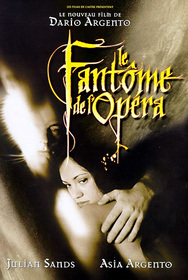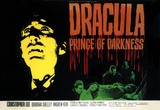Our editor-in-chief Nate Yapp is proud to have contributed to the new book Hidden Horror: A Celebration of 101 Underrated and Overlooked Fright Flicks, edited by Aaron Christensen. Another contributors include Anthony Timpone, B.J. Colangelo, Dave Alexander, Classic-Horror.com's own Robert C. Ring and John W. Bowen. Pick up a copy today from Amazon.com!
Phantom of the Opera (1998)
My name is Christina, and I love Dario Argento’s Phantom of the Opera. There. I said it. Alas, this means I must now be a social pariah among horror fans. Even – nay, especially – among Dario Argento fans. For some reason, there are few films more maligned. There are two common excuses for this. The first: it’s over the top. Well, yes. The story of Phantom of the Opera is. Opera is. C’est l’opéra. The second excuse is that it’s ‘just not Argento’. However, since it could hardly be more Argento if the Phantom went around in black gloves and one of the Three Mothers was found mysteriously lurking under the stage, I’d suggest that this statement hides a different gripe. What people really want to say is, ‘it’s just not giallo’. Sit down, folks. I have a newsflash. "The Phantom of the Opera" was written by Gaston Leroux in eighteenth century France. Eighteenth Century French authors did not write giallos. And I think they can be forgiven for this. What? You thought Andrew Lloyd Webber made up this story?
Phantom is your basic Beauty and the Beast story, set in and under the Paris Opéra. The ‘Phantom’ (Julian Sands) is an outcast genius living in the waterlogged underbelly of the opera house. He falls in love with a beautiful chorus girl, Christine Daée (Asia Argento), and turns the world upside-down, murdering and maiming people in his wake, to possess her and make her dreams of stardom come true. Christine herself is caught between the passionate but dangerous Phantom and kind but ordinary admirer Raoul (Andrea di Stefano). All this falls nicely in line with the actual plot of the novel. However, it would not be an Argento movie (and I say this with genuine affection) without a few incomprehensible plot points. So instead of being scarred from birth and forced to wear a mask (as in the original), this Phantom has an unblemished face but was unfortunately raised by rats. Hmm. Yes. He also appears at points in the film to have a very gratuitous rat fetish, allowing the beasts to crawl over his naked skin as he reclines on a chaise longue. I personally could live without that, but it takes all sorts…
Argento fans will not be disappointed with the gore level in this movie, nor with the quality of its presentation. His violence is, as usual, almost balletic in its stylised grace. For sheer innovation it does not rival, say, the most famous images from Opera (these two films are not to be confused), but it certainly delivers. Visually, this is a beautiful movie. The sets are lush and excessive, as are the costumes. Moreover, it includes one of the most beautiful couplings ever to grace the screen. You may like nothing else about this film, but I’d defy anyone to fail to enjoy the sight of Asia Argento and Julian Sands in close proximity! To add to the film’s aesthetic value is a deliriously beautiful orchestral score by Ennio Morricone, whose haunting theme stays with you long after the movie is over.
You may have noticed, then, that I very much like this film. However, there are certainly cases against it. Its greatest and most overt problem is the fact that it is an English language film made by an Italian crew. And it shows. The dialogue is badly dubbed, the script changeable and often dire, and the acting from the supporting cast wooden. Argento and Sands do the best they can with average material, and often manage to be quite compelling. Argento lights up the screen as always with her peculiar grace and beauty, and Sands is brooding and gloriously unbalanced. They have, however, evidently had to work very hard on this, because the language barrier remains one of the worst aspects of the movie. The other major downfall of the movie is less easy to define. It is almost as if the film is trying to be every kind of film and thereby failing to be any. Poignancy stumbles over madcap comedy, credibility jousts for prime position with seedy exploitation. The result is bitty and unfocused.
Dario Argento’s Phantom of the Opera is certainly a strange film, and it has justified much criticism. It is, however, criticised mainly for the wrong reasons. I would conclude by saying that this is not a film for everyone. It is not a film for people who get annoyed with Donnie Darko because they can see holes in the logic, or for those who will watch anything as long as it has profound meaning. This is a film particularly – almost solely – suited to people who like their films beautiful, people who are swayed by aesthetics. Enjoy this film for what it is: silly, excessive, but very, very pretty.








